Speaking of effective citizen oversight and review of development, planning, and land use issues
 Philadelphia City Hall photo by Jim Frizzell.
Philadelphia City Hall photo by Jim Frizzell.Yesterday's Philadelphia Inquirer has an article "Communities must review projects," by members of the Design Advocacy Group about how community review of development and land use issues needs to be effective, organized, and thorough. From the article:
"To fill the void and to provide a public voice to advocate for good design, several members of the volunteer Design Advocacy Group of Philadelphia have put together a list of 18 questions for community groups and individuals who wish to evaluate development projects and provide constructive feedback to developers, public agencies and elected officials. The questions are arranged into three categories, and taken together, their answers provide a pretty good overview of what design is all about.
Neighborhood context: These questions ask about the proposed use(s) and density of a project to determine whether it is appropriate to the neighborhood and its current identity and to the transportation infrastructure. Also addressed are any historic assets that may exist in the area and how they will be treated, along with any public amenities a developer might include.
1. Has the developer presented the project to the local civic association? If so, how did the association respond?
2. Is the proposed program appropriate to the particular site and to the neighborhood in both density and diversity of use?
3. Can the proposed density of development be supported by the existing transportation infrastructure?
4. Would the proposed use and design make a positive contribution to the identity of the surrounding neighborhood?
5. Would the project enhance pedestrian linkages to community amenities such as the riverfronts, schools, parks, libraries, and transit stops?
6. What public amenities, if any, are included in the project?
7. Does the project compromise or destroy important historic assets? If so, would it be possible to incorporate those assets into the design of the project?
8. Is there a neighborhood strategic plan, and, if so, does the proposed development relate positively to it?
Street life: The value of existing street life and maintaining a comfortable interaction between pedestrians and vehicles is explored here. Attention is focused on how the building would be located on the site and how its parking and landscaping are handled.
1. Does the proposed development maintain or strengthen an existing "street edge", and does it contribute to street life and activity on the immediate block?
2. Are building entrances and curb-cuts, service entries or vehicular access designed to create safe, comfortable interactions between pedestrians, bicycles and cars?
3. Is parking handled in a way to minimize its impact on the surroundings? Has underground parking been utilized to minimize surface parking?
4. Is the proposed landscaping adequate and appropriate and has it been designed to link the building with its site in a meaningful way?
5. Will the proposed development incorporate existing street trees and/or add new street trees and plantings?
Building and site plan: Existing zoning and use regulations are handled here, and whether the variances being requested are consistent with the intent of the existing rules. The proposed building's effect on light and views from surrounding buildings is reviewed, and whether ecologically sustainable materials are to be used.
1. What are the existing zoning and land-use regulations for the project site and does the proposed project comply?
2. What variances are being requested, and are they consistent with the intent of the current zoning?
3. Does the design respect the physical character and scale of the surrounding buildings without necessarily replicating an historic style?
4. Will natural light or views from the surrounding buildings and the street be compromised or lost?
5. Does the design utilize sustainable materials and building practices?
Click here for original document, including a great glossary of terms.
_________
Tools and checklists such as these, and understanding how to apply these principles to the projects that come before an ANC can go a long way towards getting a better project.
Other sections that could be added concern broader transportation questions-- e.g., ANC6C encourages new apartment and condominum developments to negotiate access to shared car services such as Flexcar and Zipcar. This should happen at Senate Square--and housing -affordable housing questions, and environmental (green roofs, water runoff, energy efficiency, etc.) issues.
ANC6C has what it calls a "Community Benefits Questionnaire" that touches on some of these issues.
MORE IMPORTANTLY, these are the principles that developers should follow BEFORE they unveil a "finished" project.
Too bad such isn't required as part of the development-zoning-land use-planning process to begin with.
Also useful is the Community Benefits Agreements Negotiating Handbook from the California Partnership.
 Traditionally no building was to be taller than William Penn's statue atop City Hall, but times change, and ...it wasn't in the zoning code.
Traditionally no building was to be taller than William Penn's statue atop City Hall, but times change, and ...it wasn't in the zoning code.



1 Comments:
Updated links:
https://designadvocacy.org/uploads/attachments/cjjabsfrh03eihiqf2ijtry5b-urban-design-evaluation.pdf
https://designadvocacy.org/advocacy/urban-design-evaluation3
1/11/2021
Post a Comment
<< Home